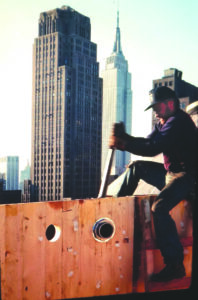Life Sketches by Terry Berkson
City Silos

Not long ago, most dairy farms in New York State had at least one silo. Today, many farmers have abandoned the use of these classic cylinders in exchange for modern innovations like silage bags and concrete-sided bunks. “They’re not much to look at,” says retired silo salesman Paul Sarafin, “but they get the job done.”
Unlike the demise of the farm silo, city silos are as popular as ever. Like a wooden warhead perched atop a missile of stone and concrete, the rooftop water tank is as familiar on the New York City skyline as chrome and glass. It bears a payload of cool, clear water, making high-rise life possible. This seemingly antiquated barrel, similar to one built well over a hundred years ago with virtually the same methods and materials, has stood against the inescapable tides of time. Without it, apartments and offices above the sixth floor would be left high and dry. Water pressure from the street only covers the lower floors. Taller buildings need tanks in which to store water, pumped electronically to the roof and then fed down through pipes by gravity.
One company that got into the water storage business on the ground floor was Rosenwach, a family-run firm that has been operating for more than four generations. Harris Rosenwach, the patriarch founder, lived in a small village outside Warsaw where he had made wooden tubs for washing, bathing and for watering horses. He emigrated to New York in 1894, hoping to earn enough money to bring his family across to a better life. He secured a job erecting roof tanks for one William Dalton, who had gone into business just after the Civil War. In 1896, Dalton died and Harris bought the business from his widow for $55.
Now there are more roof tanks in New York City bearing the flower-shaped Rosenwach “R” than ever before. In spite of many years of use, the tanks and construction methods remain almost the same. The coopers who build roof tanks still employ hoops to hold their watertight vessels together. According to Andrew Rosenwach, the current president of the company, the best tanks are built from top grade California redwood taken from the lower, stronger part of the tree. Yellow cedar grown on Vancouver Island is also a preferred material. Rosenwach prefabricates a tank by cutting the lumber at its mill in Brooklyn.
High on a rooftop, a crew of five men begins to assemble a replacement tank. The men are at home walking on I-beams that hold the tank high over the roof. They seem unfazed that the edge of the building is near, the street far below. Sure hands grip the blushing redwood pieces. There are no wasted moves or steps. The job will be completed by the end of the day so the building can once again have water. The smell of sap permeates the air. When dropped or bumped or squeezed, the wood has a mellow voice of its own. Slowly, as the morning passes, the tank takes shape, first the bottom, then the sides, then the hoops to hold everything together. Each move is deliberate and methodical, a ritual uniting all the pieces, saying, “With this hoop I thee wed.” The men, too, seem to be wed to the wood and the hard work.
At noon they break for lunch. Even this part of the day is not without structure. They sit in a loose circle on the roof below the tank. The job has been going well. There’s an atmosphere of contentment and self-satisfaction. They joke and talk sports and movies. One worker, originally from Poland, tells of hunting 60-pound rabbits as a boy. He is earnest but the others laugh in disbelief.
When back to work, the men cut and install the beams that will support the crawl space between the top of the tank and the conical cover that serves as a roof. Like tightrope walkers, they move around the rim of the tank to place the supports. Already the pumps have been turned on. Water gushes in, swelling the wood until all leaks have stopped.
Perhaps these workers are guarding a well-kept secret. Though the pay is good, few know of the tank trade. The Rosenwachs say it’s hard to find men. Perhaps they should look to farm country where many silo builders have lost their jobs.
Great-grandfather Harris would surely be glad to know that his $55 business now brings an average of $75,000 for a single tank. “As old fashioned as they may look,” says Andrew Rosenwach, “there isn’t a better way to store water or a better material to use for tanks than wood.” Even if there were something new and revolutionary, it would be understandable if he and his men kept a conical cover on it — and stood, like their “city silos,” against the ineluctable tides of time.

